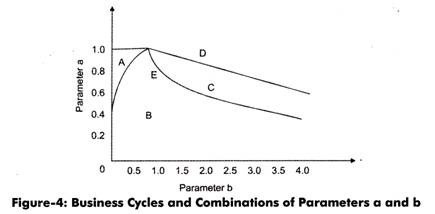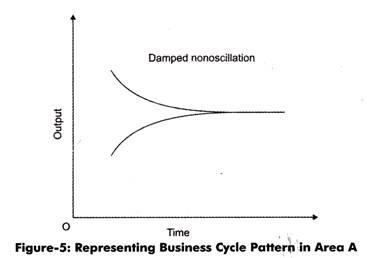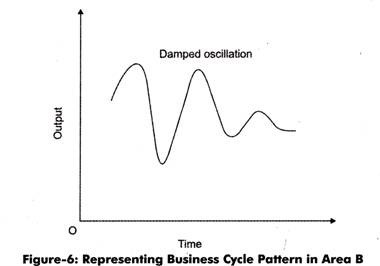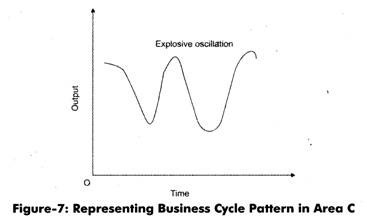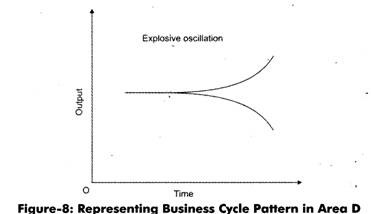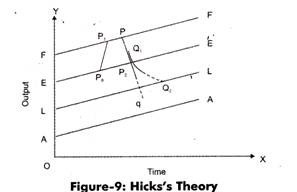Some of the most important theories of business cycles are as follows:
1. Pure Monetary Theory 2. Monetary Over-Investment Theory 3. Schumpeter’s Theory of Innovation 4. Keynes Theory 5. Samuelson’s Model of Multiplier Accelerator Interaction 6. Hicks’s Theory.
A number of theories have been developed by different economists from time to time to understand the concept of business cycles. In the first half of twentieth century, various new and important concepts related to business cycles come into existence.
However, in nineteenth century, many of the classical economists, such as Adam Smith, Miller, and Ricardo, have conducted a study on business cycles. They linked economic activities with the Say’s law, which states that supply creates its own demand. They believed that stability of an economy depends on market forces. After that, many other economists, such as Keynes and Hick, had provided a framework to understand business cycles.
ADVERTISEMENTS:
The different theories of business cycle are shown in Figure-3:
The different theories of business cycles (as shown in Figure-3) are explained in detail.
1. Pure Monetary Theory:
ADVERTISEMENTS:
The traditional business cycle theorists take into consideration the monetary and credit system of an economy to analyze business cycles. Therefore, theories developed by these traditional theorists are called monetary theory of business cycle. The monetary theory states that the business cycle is a result of changes in monetary and credit market conditions. Hawtrey, the main supporter of this theory, advocated that business cycles are the continuous phases of inflation and deflation. According to him, changes in an economy take place due to changes in the flow of money.
For example, when there is increase in money supply, there would be increase in prices, profits, and total output. This results in the growth of an economy. On the other hand, a fall in money supply would result in decrease in prices, profit, and total output, which would lead to decline of an economy. Apart from this, Hawtrey also advocated that the main factor that influences the flow of money is credit mechanism. In economy, the banking system plays an important role in increasing money flow by providing credit.
An economy shows growth when the volume of bank credit increases. This increase in the growth continues till the volume of bank credit increases. Banks offer credit facilities to individuals or organizations due to the fact that banks find it profitable to provide credit on easy terms.
The easy availability of funds from banks helps organizations to perform various business activities. This leads to increase in various investment opportunities, which further results in deepening and widening of capital. Apart from this, credit provided by banks on easy terms helps organizations to expand their production.
ADVERTISEMENTS:
When an organization increases its production, the supply of its products also increases to a certain limit. After that, the rate of increase in demand of products in market is higher than the rate of increase in supply. Consequently, the prices of products increases. Therefore, credit expansion helps in expansion of economy. On the contrary, the economic condition is reversed when the bank starts withdrawing credit from market or stop lending money.
This is because of the reason that the cash reserves of bank are washed-out due to the following reasons:
a. Increase in loans and advance provided by banks
b. Reduction in inflow of deposits
c. Withdrawal of deposits for better investment opportunities
When banks stop providing credit, it reduces investment by businessmen. This leads to the decrease in the demand for consumer and capital goods, prices, and consumption. This marks the symptoms of recession.
Some of the points on which the pure monetary theory is criticized are as follows:
a. Regards business cycle as monetary phenomenon that is not true. Apart from monetary factors, several non-monetary factors, such as new investment demands, cost structure, and expectations of businessmen, can also produce changes in economic activities.
b. Describes only expansion and recession phases and fails to explain the intermediary phases of business cycles.
ADVERTISEMENTS:
c. Assumes that businessmen are more sensitive to the interest rates that is not true rather they are more concerned about the future opportunities.
2. Monetary Over-Investment Theory:
Monetary over-investment theory focuses mainly on the imbalance between actual and desired investments. According to this theory, the actual investment is much higher than the desired investment. This theory was given by Hayek.
According to him, the investment and consumption patterns of an economy should match with each other to bring the economy in equilibrium. For stabilizing this equilibrium, the voluntary savings should be equal to actual investment in an economy.
ADVERTISEMENTS:
In an economy, generally, the total investment is distributed among industries in such a way that each industry produces products to a limit, so that its demand and supply are equal. This implies that the investment at every level and for every product in the whole economy is equal. As a result, there would be no expansion and contraction and the economy would always be in equilibrium.
According to this theory, changes in economic conditions would occur only when the money supply and investment-saving relations show fluctuations. The investment-saving relations are affected when there is an increase in investment opportunities and voluntary savings are constant.
Investment opportunities increase due to several reasons, such as low interest rates, increased marginal efficiency of capital, and increase in expectations of businessmen. Apart from this, when banks start supporting industries for investment by lending money at lower rates, it results in an increase in investment.
This may result in the condition of overinvestment mainly in capital good industries. In such a case, investment and savings increase, but the consumption remains unaffected as there is no change in consumer goods industries.
ADVERTISEMENTS:
Consequently, profit increases with increase in investment opportunities, which further results in an increase in the demand for various products and services. The demand for products and services exceeds the supply of products and services.
This leads to inflation in the economy, which reduces the purchasing power of individuals. Therefore, with decrease in the purchasing power of individuals, the real demand for products does not increase at the same rate at which the investment increases. The real investment is done at the cost of real consumption.
The balance between the investment and consumer demand is disturbed. As a result, it is difficult to maintain the current rate of investment. The demand of consumer goods would be dependent on the income of individuals.
An increase in the income level would result in the increase of consumer goods. However, the increase in consumer goods is more than the increase in capital goods. Therefore, people would invest in consumer goods rather than in capital goods. Consequently, the demand for bank credit also increases.
However, the bankers are not ready to lend money because of the demand for funds from consumer and capital goods industry both. This leads to recession in the economy. As a result, economic activities, such as employment, investment, savings, consumption, and prices of goods and services, start declining.
Some of the limitations of monetary over-investment theory are as follows:
ADVERTISEMENTS:
a. Assumes that when the market rate of interest is lower than the natural market rate of interest, the bank credit flows to the capital goods industry. This is applicable only in the situation of full employment. However, business cycles are the part of an economy and can take place under improper utilization of resources.
b. Considers interest rate as the most important factor that affects investment. However, there are several factors, such as capital goods cost and businessmen expectations, which can influence investment.
c. Focuses on balance between consumer goods and investment, which is not much required.
3. Schumpeter’s Theory of Innovation:
The other theories of business cycles lay emphasis on investment and monetary expansion. The Schumpeter’s theory of innovation advocates that business innovations are responsible for rapid changes in investment and business fluctuations.
According to Schumpeter said, “Business cycles are almost exclusively the result of innovations in the industrial and commercial organization. Innovations are such changes of the combination of the factors of production as cannot be effected by infinitesimal steps or variations on the margin. [Innovation] consists primarily in changes in methods of production and transportation, or changes in industrial organization, or in the production of a new article, or opening of a new market or of new sources of material.”
ADVERTISEMENTS:
According to Schumpeter, innovation refers to an application of a new technique of production or new machinery or a new concept to reduce cost and increase profit. In addition, he propounded that innovations are responsible for the occurrence of business cycles. He also designed a model having two stages, namely, first approximation and second approximation.
The two stages of the model are discussed as follows:
(a) First Approximation:
Deals with the effect of innovatory ideas on an economy in the beginning. First approximation is the startup stage of innovation in which the economy is in equilibrium. This implies when Marginal Cost (MC) is equal to Marginal Revenue (MR) and Average Cost (AC) is equal to price. In addition, at this stage, there is no involuntary unemployment.
In equilibrium, organizations lack idle funds or surplus funds to invest. In such a case, banks are the only source of funds for innovators. When the innovators get the desired fund from banks, they purchase inputs for production at a higher price to make these inputs available only for innovation purposes.
Increase in prices of inputs result in the rise of prices. Over time, competitors also start copying innovation and acquire funds from bank. As a result, the output and profit of organizations start increasing.
ADVERTISEMENTS:
However, after a certain point of time, profit shows decline with a decrease in output prices. Simultaneously, debtors need to repay their debts to bank. This leads to decrease in the flow of money, which finally results in recession.
(b) Second Approximation:
Deals with the subsequent effects of first approximation. It is related to the speculation of future economic conditions. In first approximation, it is assumed by investors that the expansion phase would not be affected in future, especially in capital goods industries. On the basis of this belief, investors take large amounts of money from banks.
In addition, in this stage, customers perceive an increase in the durable goods in future and therefore, start purchasing goods at present by borrowing funds. When the prices start falling, debtors are in the worst situation because they are not able to repay loan and meet their basic needs. This leads to depression in the economy.
4. Keynes Theory:
Keynes theory was developed in 1930s, which was the period when whole world was going through great depression. This theory is the reply of Keynes to classical economists. According to classical economists, if there is high unemployment condition in an economy, then economic forces, such as demand and supply, would act in a manner to bring back full employment condition.
ADVERTISEMENTS:
In his theory of business cycles, Keynes advocated that the total demand helps in the determination of various economic factors, such as income, employment, and output. The total demand refers to the demand of consumer and capital goods.
In such a case, total investment and expenditure on products and services is more, the level of production would increase. When the level of production increases, it results in the increase of employment opportunities and income level. However, if the total demand is low, the level of production would also be less.
Consequently, the income, output and investment would also be low. Therefore, changes in income and output level are produced by changes in total demand. The total demand is further affected by changes in the demand of investment, which depends on the rate of interest and expected rate of profit.
Keynes referred expected rate of profit as the marginal efficiency of capital. Expected rate of profit is the difference between the expected revenue generated by the capital employed and the cost incurred to employ that capital.
In case, the expected rate of profit is greater than the current rate of interest, then the investors would invest more. On the other hand, the marginal efficiency of capital is determined by expected return from capital goods and cost involved in the replacement of capital goods.
Marginal efficiency of a capital increases due to new inventions or innovations in economic factors, such as product, production technique, investment option, assuming that prices would rise in future. On the other hand, it decreases due to various reasons, such as decrease in prices, increase in costs, and inefficiency of the production process.
According to Keynes theory, in the expansion phase of business cycle, investors are positive about economic conditions, thus, they overestimate the rate of return from an investment. The rate of return increases until the full employment condition is not achieved.
When the economy is on the path of achieving full employment, this phase is termed as boom phase. In the boom phase, investors are not able to diagnose the fall in marginal efficiency of capital and even do not consider the rate of interest. As a result, the profit from investments starts Calling due to the increase in the cost of investment and production of goods and services. This situation results in the contraction or recession in economy.
This is because the rate of decrease in the marginal efficiency of capital is more than that of current rate of interest. In addition, in this situation, investment opportunities shrink. Banks are not also able to provide credit because of the lack of funds.
Current rate of interest is higher that encourages people to save rather than invest. As a result, the demand for consumer and capital goods decreases. Further, the income and employment level decreases and economy reaches to the phase of depression.
Keynes has proposed three types of propensities to understand business cycles. These are propensity to save, propensity to consume, and propensity of marginal efficiency of capital. He has also developed a concept of multiplier that represents changes in income level produced by the changes in investment.
Keynes also advocated that the expansion of business cycle occurs due to increase in marginal efficiency of capital. This encourages investors (including individuals and organizations) to invest. Organizations replace their capital goods and start production.
As a result, the income of individuals increases, which further increases the rate of consumption. This increases the profit of organizations, which finally lead to an increase in the total income and investment level of an economy. This marks the recovery phase of an economy.
Some points of criticism of Keynes theory are as follows:
a. Fails to explain the recurrence of business cycles.
b. Ignores the accelerator’s role to describe business cycles. However, a business cycle can be explained property with the help of multiplier acceleration interaction.
c. Offers only a systematic framework for business cycles, not the whole concept.
5. Samuelson’s Model of Multiplier Accelerator Interaction:
The economists of post-Keynesian period emphasized the need of both multiplier and accelerator concepts to explain business cycles. Samuelson’s model of multiplier accelerator interaction was the first model that represents interaction between these two concepts.
In his model, Samuelson has described the way the multiplier and accelerator interact with each other for generating income and increasing consumption and demand of investment. He also describes how these two factors are responsible for creating economic fluctuations.
Samuelson used two concepts, namely, autonomous and derived investment, to explain his model. Autonomous investment refers to the investment due to exogenous factors, such as new product, production technique, and market.
On the other hand, derived investment refers to the increase in the investment of capital goods produced due to increase in the demand of consumer goods. When autonomous investment occurs in an economy, the income level also increases.
This brought the role of multiplier into account. The income level helps in determining the marginal propensity to consume. If the income level increases, then the demand for consumer goods also increases.
The supply of consumer goods should satisfy the demand for consumer goods. This is possible when the production technique is capable to produce a large quantity of products and services. This encourages organizations to invest more to develop advanced production techniques and increase production for meeting consumer demand.
Therefore, the consumption affects the demand of investment. This is referred as derived investment. This marks the starting of the acceleration process, which results in further increase in income level.
An increase in the income level would increase the demand of consumer goods. In this manner, the multiplier and accelerator interact with each other and make the income grow at a much higher rate than expected.
Autonomous investment leads to multiplier effect that result in derived investment. This is called acceleration of investment. Derived investment would make the accelerator to come into action. This is termed as multiplier-acceleration interaction.
Samuelson made certain assumptions for the explanation of business cycles. Some of the assumptions are that the production capacity is limited and consumption takes place after a gap of one year.
Another assumption made by him is that there would be a gap of one year between the increase in consumption and increase in the demand of investment. In addition, he assumed that there would be no government activity and foreign trade in the economy.
According to the assumption given by Samuelson that there would be no government activity and foreign trade, the equilibrium would be achieved when
Yt = Ct + It
Where, Yt = National income
Ct = Total consumption expenditure
It = Investment expenditure
t = Time period
According to the assumption that consumption takes place after a gap of one year, the consumption function would be represented as follows:
Ct = α Yt-1
Where, Yt-1 = Income for t-1 time period
α = ∆C/∆Y (multiplier propensity to consume)
Investment and consumption has a time lag of one year; therefore, the investment function can be expressed a follows:
It = b (Ct –Ct-1)
Where, b = capital/output ratio (helps in determination of acceleration)
By putting the value of Ct and It in the first equation of national income, we get
Yt = α Yt-1 + b (Ct – Ct-1)
If Ct = α Yt-1, then Ct-1 = α Yt-2. Putting the value of Ct-1 in the preceding equation, we get
Yt = α Yt-1 + b (α Yt-1 -α Yt-2)
Yt = α (1 + b) Yt-1 – abYt-2 (equation for equilibrium)
With the help of preceding equation, the income level for past and future can be determined if the values of a, b and income of two preceding years are given. It can be depicted from the preceding equation that the changes in income level can be affected by the values of α and b.
The different combinations of α and b give rise to fluctuations in business cycles as shown in Figure-4:
In Figure-4, the areas A, B, C, and D represents the different phases of business cycles. The types of different cycles represented by A, B, C, and D are described in detail with the help of the following points:
A: Refers to the area at which the income level increases or decreases at the decreasing rate and arrive at a new equilibrium point. The change in the income level would be in one-direction only.
It results in damped non-oscillation, as shown in Figure-5:
B: Refers to the area in which points, a and b, together makes amplitude cycles that gradually become smaller. This process continues till the cycles get dissolve and economy reaches to equilibrium.
This represents damped oscillations, as shown in Figure-6:
C: Refers to the area in which points, a and b, together makes amplitude cycles that become larger.
This forms explosive cycles, as shown in Figure-7:
D: Refers to the area at which the income level is increasing or decreasing at the exponential rate. This process continues till cycles reach at the bottom.
It represents one-way explosion and results in explosive oscillations, as shown in Figure-8:
E: Refers to the point at which the oscillations are of equal amplitude.
Some of the drawbacks of Samuelson’s model are as follows:
a. Represents a simpler model that is not able to explain business cycles completely
b. Ignores other factors that influence business cycles, such as expectations of businessmen and taste and preferences of customers
c. Assumes that the capital/output ratio remains constant, which is not true.
6. Hicks’s Theory:
Hicks has associated business cycles to the growth theory of Harrod-Domar. According to him, business cycles take place simultaneously with economic growth; therefore, business cycles should be explained in association with the growth theory.
In his theory, he has used the following concepts to explain business cycles:
a. Saving-investment relation and multiplier concepts given by Keynes
b. Acceleration concept given by Clark
c. Multiplier-acceleration interaction concepts given by Samuelson
d. Growth model of Harrod-Domar
Hicks has also framed certain assumptions for describing business cycle concept.
The important assumptions of Hicks’s theory are as follows:
(a) Assumes an equilibrium rate of growth in a model economy where realized growth rate (Gr) and natural growth rate (Gn) are equal. As a result, the increase in autonomous investment is constant and is equal to the increase in voluntary savings. The equilibrium growth rate can be obtained with the help of rate of autonomous investment and voluntary savings.
(b) Assumes the consumption function given by Samuelson, which is Ct = α Yt-1. As discussed earlier, according to Samuelson theory consumption takes place after a lag of one year. The time lag in consumption occurs due to the gap between income and expenditure and gap between Gross National Product (GNP) and non-wage income.
The gap between income and expenditure produces when income is ahead of expenditure. The gap between GNP and non-wage income produces when fluctuations in GNP occur more frequently than the fluctuations in non-wage income.
The saving function becomes the function of past year’s income. With the time lag between income and investment-saving, the multiplier process has a diminishing impact on business cycles.
(c) Assumes that autonomous investment is a function of output at present. In addition, autonomous investment is used for replacing capital goods. However, induced investment is regarded as the function of changes in output.
The change in output produces induced investment, which marks the beginning of the acceleration process. The acceleration process interrelates with the multiplier effect on income and consumption.
(d) Makes use of the words ceiling and bottom for explaining the upward and downward flow of business cycles. The ceiling on upward flow is a result of scarcity of resources required. On the other hand, the bottom on downward flow does not have a direct limit on contraction. However, an indirect limit is the effect of accelerator on depression.
Hicks’s theory can be explained with the help of Figure-9:
In Figure-9, the y-axis represents the logarithms of output and employment while x-axis represents the semi-logarithm of time AA line represents the autonomous investment that is rising at the same rate.
EE line shows the equilibrium line that is a multiple of autonomous investment. FF line expresses the full employment or the peak phase of economy, while LL line expresses the trough phase of an economy.
Hicks explains business cycles by assuming that the economy has reached to Po point of equilibrium path and autonomous investment is the result of innovation. The autonomous investment results in the increase of output.
Consequently, the economy moves upward from the equilibrium path. After a certain point of time, the autonomous investment brings the multiplier process at work, which further increases output and employment. The increased output makes the induced investment to work that further results in accelerator process to work.
The multiplier-accelerator interaction results in the growth of the economy. Consequently, the economy enters in the phase of expansion. The economy moves on the expansion path of P0P1. At point P1, the economy is in full employment condition. Now, the economy cannot grow further, it can only move on the FF line.
However, it cannot remain at FF line because autonomous investment becomes constant; therefore, now at FF, only the normal autonomous investment would be produced. This infers that the expansion of the economy is governed by induced investment only.
When the economy reaches to point P1, the increase in induced investment becomes stable and the growth of economy starts declining. This is because of the reason that the output produced at FF line is not sufficient for induced investment.
As a result the induced investment stops. The decline of the economy can be postponed, if the time lag between output and investment is of three to four years. However, the decline in output cannot be ceased. When the decline in output occurs at point P then the decline in output would continue till the economy reaches back to EE line.
After arriving at EE line, it would continue to fall further. The rate of decline in economy is very slow because disinvestment depends on the rate of depreciation. The decrease in output leads to the decline in the rate of depreciation.
The effect of reverse accelerator on the depression is not as frequent as in the case of expansion. During the path Q1Q2, the induced investment is nil while autonomous investment is less than normal. In addition, the indefinite decline of economy is represented by Q1q. However, Q1q is a very rare case that does not occur normally.
When the economy reaches to trough, it moves along the LL line, which is associated with AA line that represents autonomous investment. Therefore, output starts increasing again with the increase in autonomous investment.
Increase in output makes the accelerator to work again. This phase is termed as recovery phase. Along with accelerator, multiplier also comes into action and their interaction makes economy run on the growth path and reaches to equilibrium EE line again.
There are certain limitations of Hicks’s theory, which are as follows:
a. Fails to explain the reasons for linear consumption function and constant multiplier. When the economy is going through different phases of business cycles, the income is redistributed that affects the marginal propensity to consume, which further affects the multiplier process.
b. Suspects the constancy of multiplier in changing economic conditions. Without practical evidence, the accelerator and multiplier cannot be assumed to be constant.
c. Takes into consideration the abstract theory, which cannot be applied in the real world.

